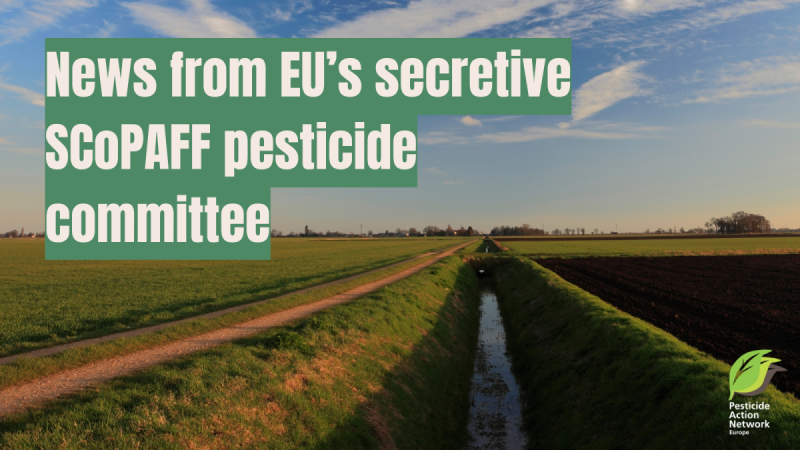Important decisions in relation to some toxic pesticides were taken in the recent meeting of the EU pesticide committee SCoPAFF, behind closed doors. Two PFAS pesticides will be banned, but only because the manufacturers retracted the application. It remains urgent for the Commission and Member States to take measures to ban all PFAS pesticides to protect our drinking water and health. A positive element was the ban of an endocrine-disrupting pesticide. A very negative step is the proposal to reauthorise the use of reprotoxic fungicide 8-hydroxyquinoline, motivated by an unscientific statement that its use will result in no human exposure to this pesticide.
The last Pesticide Committee (SCoPAFF) meeting of the EU Member States took place on October 2-3, 2024. It led to several important decisions regarding the regulation of hazardous pesticides in Europe. Positive steps have been made, particularly in relation to the bans of endocrine-disrupting metribuzin and the PFAS substance tritosulfuron. However, the lack of action to prioritise the protection of health and our drinking water resources, and continued prolongation of the approval of very hazardous substances are a serious concern.
Positive step forwards
Endocrine-disrupting herbicide ban
A year after discussions between Member States and the European Commission began, the proposed ban on the herbicide metribuzin was finally adopted. This substance is the ninth to be banned in Europe because it meets the endocrine-disruption criteria adopted in 2018. On top of its endocrine-disrupting properties for humans [1], it was found to be highly toxic to bees.
PFAS ban
The PFAS substance tritosulfuron was banned because its manufacturer decided to withdraw its renewal application, anticipating that the safety approval criteria are not met. This is great news as the herbicide is broken down to the ubiquitous water contaminant TFA [2]. This small and mobile PFAS that is found in our drinking water all across Europe is now proposed for classification as toxic for reproduction category 1B, acute toxic 3, very persistent and very mobile (vPvM) and persistent, mobile and toxic (PMT). The approval period for another PFAS pesticide - the herbicide flumetralin - has been shortened to January 2025 instead of May 2026, again following the withdrawal of the renewal application by its manufacturer.
However, this progress was a result of the manufacturer’s decisions. It did not come from a strong commitment from the European Commission and Member States to ban these forever pollutants, towards PFAS-free agriculture and to protect our drinking water. PAN Europe continues to call for urgent action against PFAS pesticides whose renewal application has been maintained. This includes flutolanil and flufenacet [3]. This second substance, which is one of the most widely sold PFAS pesticides in several Member States (and therefore the highest emitter of TFA), is an endocrine disruptor for humans and non-target species, according to EFSA's conclusions published in September 2024. After 11 and a half years of repeated prolongations of its current approval period, including a lengthy assessment of endocrine-disrupting properties, it is high time to ban this substance.
Concerning developments
Prolongation and possible renewal of a reprotoxic substance?
Worryingly, Member States also adopted the Commission proposal to prolong the approval of several hazardous substances, including 8-hydroxyquinoline, a substance classified as toxic to reproduction 1B since 2015 [4]. Under the EU Pesticide Regulation, substances that present such hazards cannot be approved.
An exception is possible if “negligible exposure” to humans can be convincingly demonstrated, which means that the conditions of use exclude any contact with humans and result in no residues of the pesticide in food. This exceptional clause of the regulation has never resulted in the approval of a hazardous pesticide since the Pesticide Regulation came into force in 2011. This could change with 8-hydroxyquinoline if Member States support the European Commission's proposal.
The proposal is however based on an industry study presenting major flaws that do not allow robust scientific conclusions to be drawn. Moreover, this study does not take into account realistic conditions of use. For example, the study assumes that the greenhouse inside and outdoor temperatures are approximately 20°C. In fact, the greenhouse temperature in southern European countries is about 40°C. Since the volume of vapour pressure of 8-hydroxyquinoline is dependent on the temperature, the level of exposure to 8-hydroxyquinoline is highly underestimated. This proposal stems from a very lax interpretation of the exceptional provisions in the negligible exposure clause. It would set a dangerous precedent, opening the door to the reauthorisation of other hazardous substances. PAN Europe will fight against this renewal [5].
PAN Europe had sent its position on all these issues and more to the Commission and Member States. Read more here: PAN Europe's letter to SCoPAFF 24 September 2024
Notes:
(1) Hormone disrupting pesticides (EDCs)
(2) TFA: The Forever Chemical in the Water We Drink
(3) Bayer and BASF: A business model that pollutes our drinking water?
(4) Factsheet on the fungicide 8-hydroxyquinoline, one of our Toxic 12
(5) 'Don’t worry, you will not be exposed to this very harmful pesticide'
